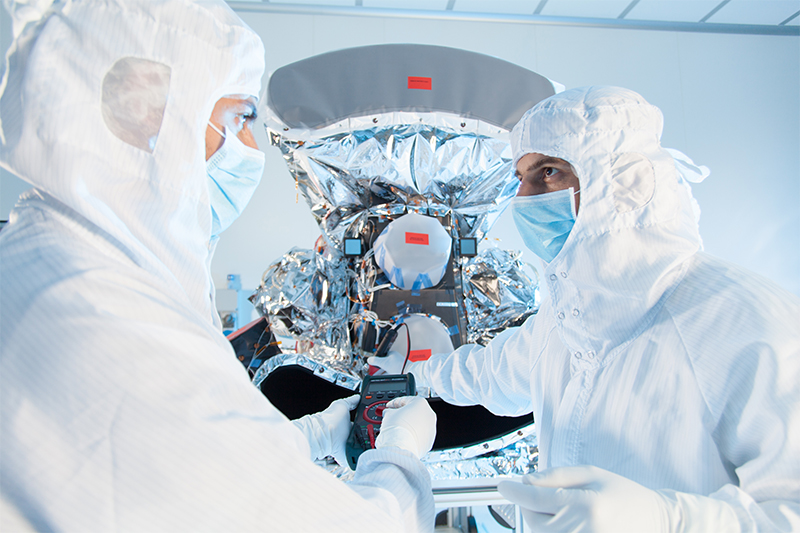Among its many activities within the space sector, Leonardo has distinguished itself as the project leader and final integrator of the Sea and Land Surface Temperature Radiometer (SLSTR) sensor installed on the two Sentinel-3 series satellites (3A and 3B) – part of the European Union’s (EU) Copernicus Earth observation programme. Sentinel 3A was launched in 2016, followed by 3B in 2018.
The Sentinel-3 mission aims to measure – with a high degree of precision and reliability – the topography of the sea's surface and the variations in colours and surface temperature of the oceans and land masses. This is to provide key information for ocean current forecasting and environmental and climate monitoring. To fulfil this mission, each satellite is equipped with five different sensors: the Ocean and Land Colour Instrument (OLCI), the SLSTR, the SAR Radar Altimeter (SRAL), the MicroWave Radiometer (MWR) and the Precise Orbit Determination (POD). The two Sentinel-3 series satellites guarantee at least one pass per day over every location on Earth. The actual number of passes naturally depends on a location's geographical position with respect to the satellite orbits: the Equator can be visited once a day, but passes steadily become more frequent the closer a location is to the Poles.

Leonardo was responsible for creating and commissioning the SLSTR sensor. This was both a management and a technical challenge: the SLSTR has 9 spectral channels, three of which are in the visible spectrum (with a spatial resolution of 0.5km on the ground) and six in the infra-red (IR) spectrum (with a spatial resolution of 1km on the ground), with wavelengths of 3µm to 12µm. The different wavelengths are used according to the type of observation required: the 3µm and 10µm channels, for example, are used to detect large fires in sparsely populated areas like Siberia or the Amazon. The various sensors are optimised to monitor the temperature of water and the Earth’s crust, including environments with a high thermal range, such as deserts.
With both short- and long-term effects, this information is of huge importance to many public and private decision-makers. For example, tracing the evolution of the planet's climate by recording the average rise in temperatures enables the EU and its individual states to make informed decisions on their adherence to international climate treaties, on their adoption of policy measures that affect the economy and society, and on their formulation of national, European or international agendas regarding the economy and the ecological transition.

At the same time, SLSTR also provides the capacity to monitor hurricanes and other climate events, and to detect large fires in remote areas of the planet that would otherwise come to light only upon learning of the huge resulting damage. Commercial operators can also profit from the information provided, such as that regarding patterns in sea currents. Companies that specialise in sea transport, for example, can use this information to plan routes enabling merchant ships or oil tankers to consume less fuel, both saving money and protecting the environment.
The sensor’s complexity derives not only from the need to cover multiple spectrums, but also from the fact that, like all satellite payloads, it has to respect strict size and weight constraints. The whole instrument is within the dimensions of a cube of just 1.4m per side and a weight of around 160kg.

As project leader, Leonardo has managed a pool of 20 companies, which grew to 24 at the point of maximum activity. Almost all the participants were European, with the exception of one US company. The Campi Bisenzio (FI) site was the beating heart of the project, and the facility where the final assembly of the sensor took place prior to delivery to Thales Alenia Space (prime contractor for the satellites). The dense web of contacts and synergies that Leonardo had to weave with its partner companies to ensure the programme’s success was both a challenge and an opportunity. As well as language barriers, international collaborations always have to overcome an array of minor and major differences between participating companies – each with their own methods, imperfectly aligned standards and differing industrial cultures. Perfection has to be achieved in the face of these differences, with painstaking respect of contractual specifications and perfect calibration of instruments. Its success in delivering a sensor of this type places Leonardo within a very select group of global players (less than a dozen) that have the technical excellence, production capacity and management know-how needed for a complex space programme. From the financial viewpoint, the two instruments installed on the Sentinel-3A and Sentinel-3B satellites required an investment of around €100 million, including not only the production phase but also research and development. Set against the fact that they will be at the service of the entire EU, these sensors will cost European taxpayers just 30 cents per capita over 15 years, while yielding huge benefits to the environment and to the protection and preservation of life in the broadest sense. If further sensors are ordered, this cost will be reduced even further, taking advantage of all the research that has already been carried out.
The Sentinel-3 programme will continue with the 3C and 3D satellites, due in 2023 in 2025 respectively. This schedule reflects the fact that each satellite has an estimated working life of 7.5 years, with the need to have their replacements ready in advance. Leonardo is already working on its response to this year's ESA call for tenders, which among other things will require a further increase in sensor resolution and a greater number of multi-spectral channels. This undoubtedly represents a challenge for Leonardo, but the company is able to count on the unique experience it has gained in building the first two models. The outlook is excellent indeed.

